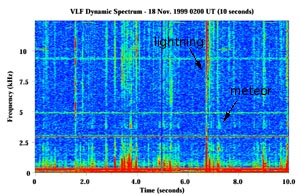|
Leonid MAC |
| home |
| View the shower |
| Mission Brief |
| Science Update |
| Media Brief |
| links |
LEONID DAILY NEWS: November 6, 2000
Figure: A false color representation of the radio spectrum during a 10 second time
interval. Orange colors show intense radio emissions.
LISTEN TO THIS!
For many years, stubborn rumours persisted that it was possible to hear bright
fireballs at the same time when spotting the meteor. A hissing sound was often
reported, sometimes so loudly that it drew attention to the fireball itself.
These anecdotes were often dismissed on grounds that
it takes sound a long time to travel the distance of
a few hundred kilometers between fireball and observer, while the light
arrives almost instantaneously. Some researchers, however, speculated that
radio signals with audible frequencies might be emitted by the meteors, which then
could interact with nearby transducers to cause an audible sound. Radio signals
are a form of electromagnetic waves and travel with the speed of light. Transducers
might be an array of objects close to the observer: pieces of paper, glasses, even tooth fillings.
Now, in the upcoming issue of Earth, Moon and Planets, Colin Price and Moshe Blum
at Tel Aviv University report the detection of numerous radio signals at the
time of the 1999 Leonid meteor storm. Sure enough, these signals peak
at 500 Hz and at 10,000 Hz. The audible range is 20-20,000 Hz.
This is unlike radio signals from distant
lightnings, which have a single peak between 5,000-10,000 Hz,
many of which were detected at the same time.
Interestingly enough, the rate of meteor detections
was highest at the time of the meteor storm, and only few detections were reported
in the night prior to the storm.
Are these signals caused by the Leonid meteors? Perhaps. There is still much to
investigate. The signals were of unusually short duration,
only about 10 milliseconds long, much shorter than a typical meteor. And although the
rate of detections more or less followed the meteor storm activity, they appeared
in high numbers a bit earlier than the storm (Full paper - PDF).
Nov. 06 - Listen to this! Nov. 04 - Fear of heights? Nov. 03 - The pale (infra-red) dot Nov. 02 - Twin showers Nov. 01 - Leonids approaching Earth Oct. 31 - Prospects for Moon Impact Studies Oct. 30 - Comet dust crumbled less fine
| ||


